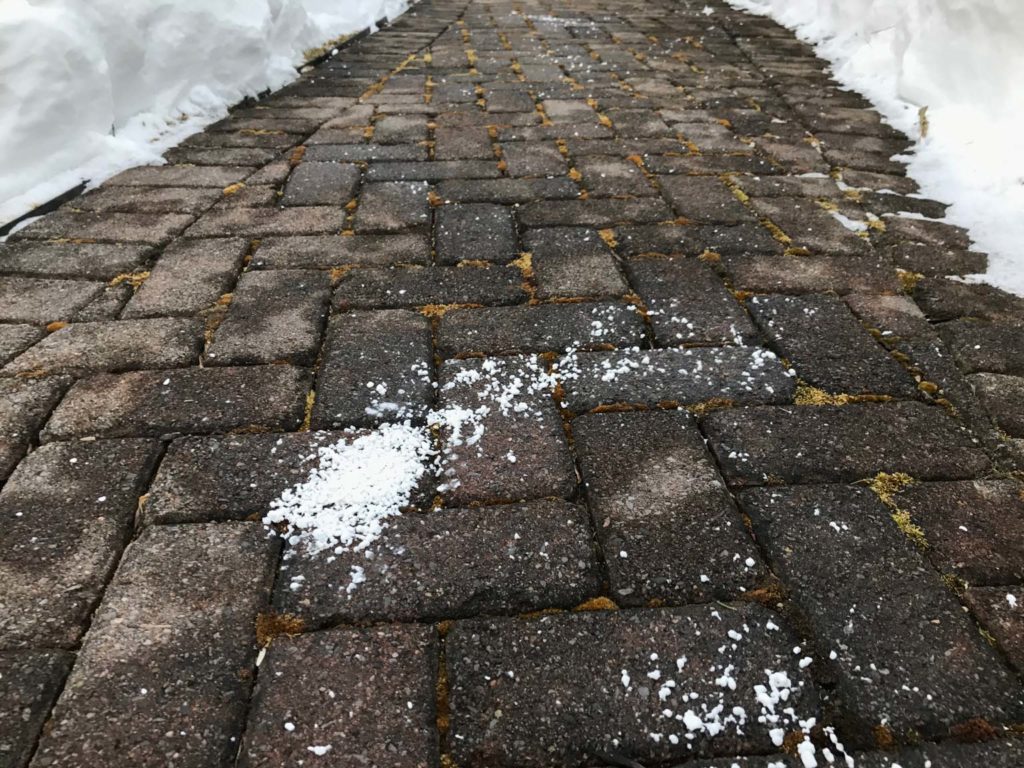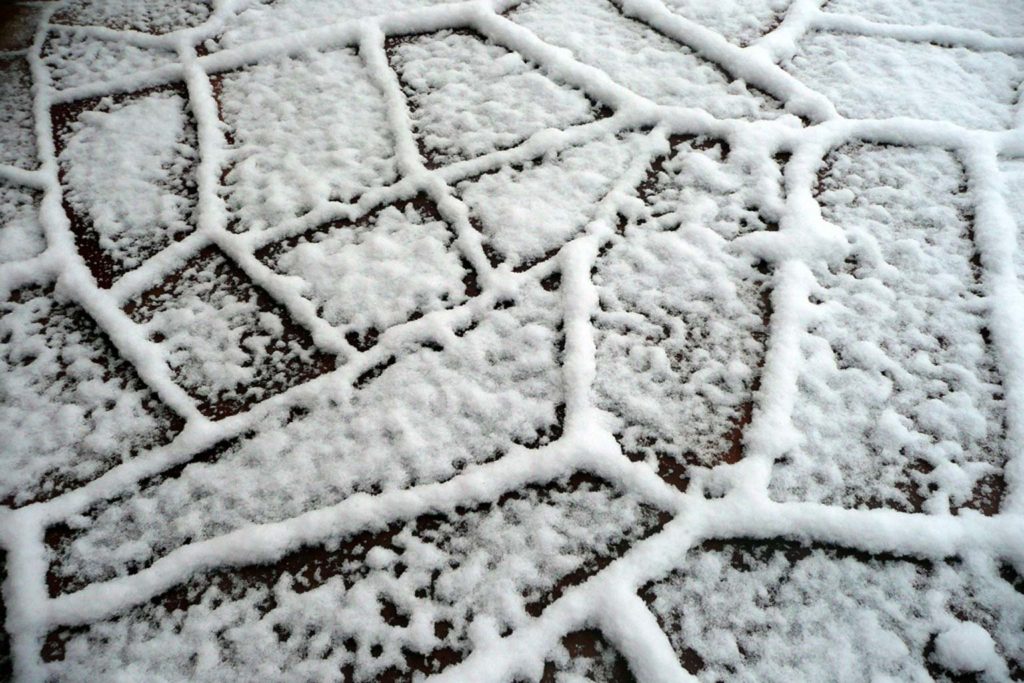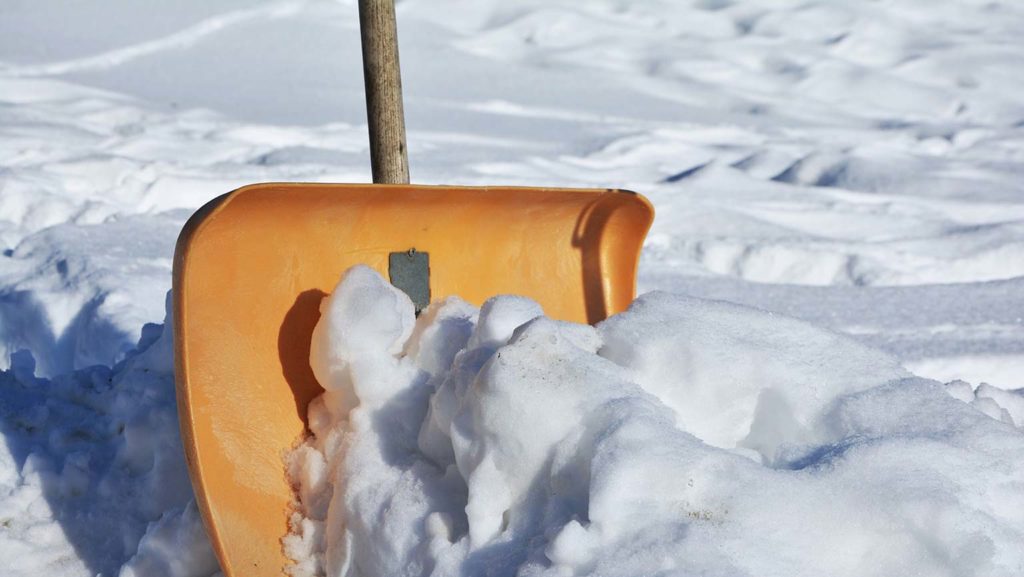When a snowstorm ends and the bright sun re-emerges, it does make the snow shoveling a more enjoyable experience. However, that same sunlight may cause some of the snow to melt only to refreeze as ice on your walks and patios. Even on flat ground, ice can be treacherous!
When ice forms on your walks and patios, what should you do? Grab some run-of-the-mill rock salt and generously spread it everywhere? Absolutely not!
Rock salt (sodium chloride) is commonly used on asphalt roads for de-icing, but that same rock salt should never be used as a de-icing agent on anything other than asphalt. Salt should not be applied to walks or patios, regardless of whether your walks and patios are natural stone, pavers, or concrete because salt will damage all surfaces other than asphalt.
So, you wonder, why is this and what should you use instead? We have the answers for you here.
How De-Icing Agents Work
De-icers work by lowering the freezing point of water. For example, when salt (sodium chloride) is combined with water, the freezing point of this salty water is going to be lower than the freezing point of fresh water (32°). The precise freezing point of the salty water will vary depending on how much salt is dissolved in the water, but likely it will be around 20°. Therefore, if the temperature is above 20°, the snowmelt + rock salt combination will remain as a liquid, but if the temperature drops below 20°, the salty water will freeze to ice. If the temperature repeatedly rises and falls above the 20° threshold, the salty water will repeatedly thaw and freeze.
Because when water freezes into ice it expands in size, this means that if the salty water has made its way into cracks and pores of your walks and patios, the repeated freezing and thawing will cause damage to the material, whether it is natural stone, pavers, or concrete. Therefore, it is best to look for a de-icing agent that has a very low freezing point when combined with snowmelt water.
Negative Effects of Applying Rock Salt to your Walks and Patios
- Corrosive to Concrete – When left to sit on a concrete surface, a salt crystal will “eat” into the surface leaving a pock mark. Certainly, if you have a paver walk or paver patio, salt will damage these because pavers are pressed concrete products.
- Corrosive to Mortared Joints – If you have a wet-laid natural stone walk or patio, then the mortared joint will be weakened when exposed to salty water and if exposed repeatedly you will start to have loose stones.
- Causes Flaking – Salt can also cause damage to the surface of a stone cause that surface to flake off. The New York Landmarks Conservancy warns that rock salt can cause “salt fretting.” This is a condition in which masonry surfaces scale and flake.
- Bleaches Surfaces – Rock salt causes discoloration to surfaces with a result looking like the surfaces was bleached. This is especially true for bluestone and other natural stone products. Rock salt has a bleach effect which can result in discolored spots or can affect an entire stone.
- Harmful to Plants – Most plants do not like a high salt content in the soil. When the salty water runs off the surface, it can accumulate in the soil and damage plant roots. It can also be absorbed by the plant and enter the plant cells or the space between the cells. This can lower the plant’s cold hardiness leaving it susceptible to freezing. (However, please note, some plants can thrive in conditions like these, such as junipers and other plants native to seashores.)
- Damages Indoor Flooring – When you step on rock salt, it often sticks to the bottom of your foot and will be transported into your home where it is then tracked throughout the house and spread on the indoor floors. Similar to the way salt will discolor stone, salt can cause damage to these interior flooring materials.
- Bad for Pets – Rock salt can irritate the paws of our four-legged friends. In addition to causing irritation to their paws, rock salt can be harmful if ingested by pets.
We know what you’re thinking. If not salt, what should I use to de-ice my walks and patios?
What Should I Use for De-Icing my Walks and Patios?
Many of the following products are better than rock salt (sodium chloride) because they have lower freezing points which result is less freezing and thawing. In addition, some have less corrosive properties. Many of these alternatives are also safer for pets and surrounding vegetation.
- Calcium Magnesium Acetate (CMA) – CMA is relatively new on the market, but it is the most widely tested and used acetate-based de-icer. It is a natural acid, soluble in water. Chemically speaking, it’s similar to vinegar. It is biodegradable and will not harm the environment when used in small amounts. It is also safer for pets. The one drawback is its price. It is much more expensive than rock salt, but it may be worth the cost if it means protecting your hardscape, pets, and plants.
- Potassium Chloride – Potassium chloride is one of the safest de-icers for pet owners. However, it can be lethal if ingested by pets with kidney disease. It is also one of the least damaging de-icers for plants when used in moderation. Unlike some of the other possible alternatives, potassium chloride’s freezing point of 15 – 20° is similar to that of rock salt.
- Magnesium Chloride – It’s one of the newest de-icers available and is great for those with pets. Much like potassium chloride, it can be lethal if swallowed by pets suffering from kidney disease. Magnesium chloride has a freezing temperature of -13°, making it extremely effective in even the coldest of weather. It releases 40% less chloride into the environment making it environmentally friendly and safe for plants. It also leaves very little residue and doesn’t track.
- Calcium Chloride – Calcium chloride has a freezing temperature of -25°, which makes it a great choice for those looking to melt ice quickly. It is also great for those who live in extremely cold climates. Many calcium chloride de-icers are engineered to reduce tracking. This is good because the de-icer will stay on the patio and walkway, as opposed to coming inside on the soles of people’s shoes.
If you are interested in purchasing one of these suggested alternatives, check your local hardware store. They should have some, if not all, of the above de-icing agents.
Other Helpful Tips
In addition to using one of the aforementioned alternatives to rock salt, these are some additional steps that you can follow for the best results:
- Pretreat. Apply a de-icer before a snow or ice event. By pretreating an area, you will need less de-icer in the long run.
- Shovel Off First. Shovel off as much of the snow and ice as possible before applying a de-icer. If you are shoveling bluestone or another natural stone product, use a plastic shovel. A metal shovel can scrape and damage the stone.
- Use Sparingly. Always read the label and apply sparingly. It is important to avoid over-applying any de-icer. Even the possible alternatives mentioned above can have negative side effects if applied in excess or allowed to pile and clump.
When it comes to removing ice from bluestone (and other natural stones), pavers, and concrete, think like a person with high blood pressure and say, “Hold the salt!” Your hardscaping, surrounding plants, and pets will thank you.









